
Jean-Pierre Couerbe
27 March 1805-11 October 1867
Couerbe, the famous French chemist, was born on 6 Germinal an 13 (27 March) in Vertheuil, a rural commune in the wine country of the Haut-Médoc, near Bordeaux. He was the fourth and youngest child of Joseph Couerbe and Magdelaine Chapellan (see: Brain chemistry and the French connection 1791-1841, Tower DB, 1994, Raven Press, New York). His father was involved in health work as a health officer or practitioner in his town. Jean-Pierre Couerbe never married, his parents died before he was 28. We have scant information about his childhood but we may guess that his father’s work decided him to go to Paris around 1825 at the age of 20, he enrolled in the École de Pharmacie. He began his training with Octave Lesueur, medicine doctor (1802-1860) in toxicology in the laboratory of Mathieu Orfila (1787-1853), brother-in-law of Lesueur and the founder of forensic toxicology. Soon after, he published the results of his first study (Réflexions sur le principe volatil du sang, J Pharm 1829, 15, 592) where he criticized the views of several senior scientists. Nevertheless, at age 27, he was quallified as “maître en pharmacie” and joined the active laboratory of PJ Pelletier (1788-1842), deputy director of the École de Pharmacie. As many others in that laboratory, he worked on the identification and characterization of “alcalis végétaux” which were later named “alcaloides” by Dumas. JB Caventou (1795-1877), professor of toxicology at the École de pharmacie worked also in the same laboratory where several important molecules have been isolated (chlorophyll, emetine, strychnine, brucine, quinine, caffeine, colchicine).
After these works and unexpectedly, he applied the techniques he used in the laboratory to brain tissue. He published an important work in 1834, presented to the Académie in 1833: “Du cerveau, considéré sous le point de vue chimique et physiologique”.
 Copy of the first page of the 1834 Couerbe’s paper
Copy of the first page of the 1834 Couerbe’s paper
Using extraction with alcohol and ether, Couerbe concluded that the brain would contain a great number of well-characterized fatty substances (stéaroconote, céphalote, éléencéphol, cérébrote, cholesterol) of wich he gave the elementary compositions. One of them, céphalote (or brain wax), was soluble in ether but not in alcohol or water, it saponifiable and contained phosphorus, and so exhibited the properties of phospholipids but he made no reference to the important observation by Vauquelin that most of the phosphorus in the brain was linked to a fatty component. “Although his elementary analysis of céphalote does not agree well with that for lecithin, his practice of characterizing each of his isolated fractions distinguished him as “the first to apply organic analysis to brain-products (JL Thudichum, The Progress of Medical Chemistry, Baillière, Tindall & Cox, London, 1896, 87”.
He also determined the presence of “cholesterol, which until now had only been found in traces in bile and in tiny amounts in blood, but in greater amounts in gallstones, was considered a morbid product; but my experiments prove quite clearly that this substance is a principal element of the nervous system and that it appears to be elaborated by it”.
Furthermore, Couerbe determined that “phosphorus really exists in cerebral matter”.
That paper was admired by JL Thudichum, the great developper of the brain lipid chemistry in the late 19th century. Indeed, that work may be considered as the foundation of “neurochemistry”, term introduced in the 1940s after the term “brain chemistry” was used between the 1880s and the 1930s (McIlwain H, Neurochem Int 1988, 12, 431).
After toxicological works on arsenic in the Orfila’s laboratory, Couerbe retired in the mid-1850s to la Gravière, a hamlet near Vertheuil, where he took an active interest in his vineyards, returning to chemical investigations related to viticulture. He died in 1867 in that place.
Devenez membre et participez au développement de la Lipidomique au XXIème siècle.
S'inscrire